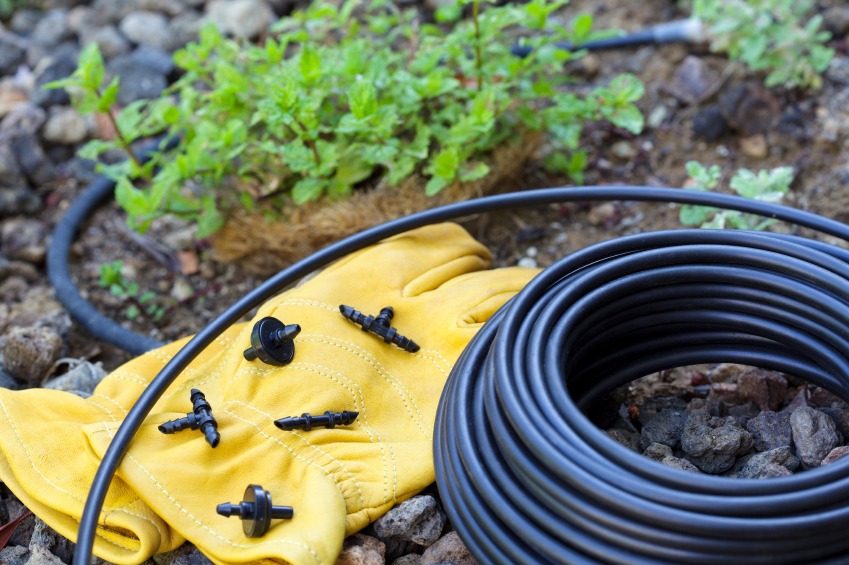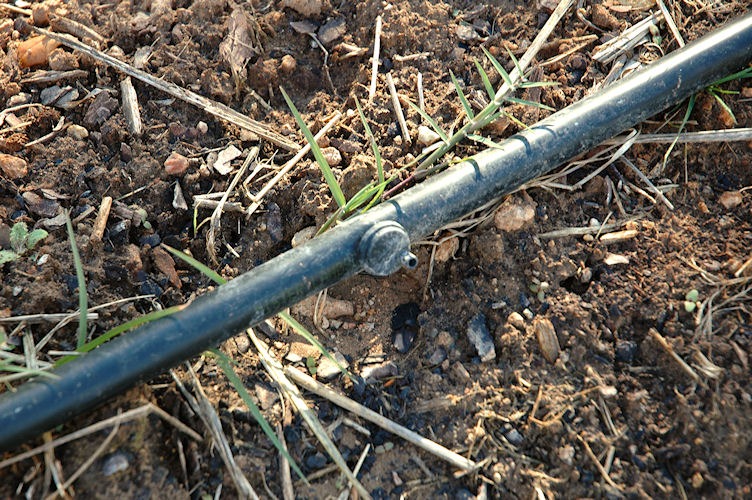How To Repair Sprinkler Drip Line
Repair Drip Irrigation Guide: How To Fix Information technology Yourself Without Your Gardener

Drip irrigation is a very mutual water-wise method of watering plants in Southern California. Nigh homeowners inherit baste systems with their homes or take them installed during landscaping renovations, but not many people e'er tinker with them.
Pressure builds, hoses become stepped on and conditions tin wearable on the parts. Eventually, small leaks or fifty-fifty huge gushers can and do occur negate the water-wise advantage of the system. Or, perchance you need to movement some plants around.
In either example, at that place is absolutely no need to rely on your gardener to administer these pocket-sized fixes, because you can do it yourself at a fraction of the expense. Here's how.
Drip Irrigation Parts to Continue on Hand
In case of emergency, information technology's ever best to keep a stash of these inexpensive parts in the garage. Retrieve that drip fittings clamp themselves together with an air tight seal that does non involve gum.
1. Drip irrigation tool –
The style depends on the manufacturer but this handy gadget is totally necessary to save your fingers and wrists from the unnecessary stress of jamming plugs and emitters into stubborn tubing. This tool can insert plugs with ease, dial holes in tubing for hoses and emitters, and some even have sharp scissors fastened to cut tubes when needed.
two. Plugs –
When holes article of clothing in the main tubing or perhaps you lot need to rearrange things based on plant growth, plugs (oft referred to as goof plugs) will finish leaks. Insert them using the drip irrigation tool or by paw.
3. Waterproof tape –
Now, this won't come up in your standard drip irrigation starter kit but having waterproof record on paw for the teeny tiny hairline leaks is sometimes enough to solve the problem in an easier style than slicing up the line.

four. Drip emitters –
These are the gadgets that command the amount of water that drips into your soil. Between the dirt in your yard and minerals in household water, drip emitters clog easily and need to exist replaced. For this reason, it's a good idea to turn on your organisation and check each emitter regularly to avoid unexpected constitute expiry.
A diversity of different emitters exist. Some expect like discs with small tube sticking out while others expect a little bit like a faucet. The most mutual emitters drip iv liters/hour of water, which equals roughly a gallon. The flow speed is normally written on the emitter merely it's tough to see in the all-time of times, and can fade with prolonged utilise.
If you have plants on a drip arrangement that aren't getting plenty h2o, alter the emitter to viii liters/hr or higher.
5. Couplers –
While not completely necessary to accept on mitt, couplers are direct, "L" shaped or "T" shaped commonly to aid weave your main drip tubing around your yard in an orderly way.
6. Extra tubing –
We'll get into this in more depth below.
Things to Know Near Drip Tubing

Earlier you lot go out and buy a agglomeration of drip supplies, remember that not all tubing is equal.
Drip tubing is the thicker tubing (unremarkably most .5 – 1.5 inches in bore) that the emitters and other distribution tubing are attached to. Think of it as the major artery running through your garden.
Distribution tubing is the smaller, ordinarily i/4″ in bore, tubing that delivers water to plants via the emitters if the primary drip tubing to a higher place is is far away.
Emitter tubing tin can exist any size just already has spaced internal emitters within that are commonly 12 – eighteen inches autonomously. It looks similar a hose with holes in information technology and is handy for watering things like footing cover or evenly-spaced plants.
Soaker hoses slowly seep water with less accurateness into a large or pocket-size infinite. We have a ane/4″ soaker hose in our vegetable garden because we change out the plants in that location ofttimes and became tired of re-arranging drip lines.
And, the most important function to think is that there is an internal hose diameter and external hose bore. The drip fittings that you purchase must match the internal dimensions of your tubing to avoid major headaches and physical strain. For example, 1/ii″ drip tubing can come up in these diameters (ID equals internal bore and OD equals exterior diameter):
1/2-inch – .520″ ID x .620″ OD
1/2-inch – .600″ ID x .700″ OD
1/ii-inch – .615″ ID x .710″ OD
This may seem like a minuscule difference but it is not. If y'all're just getting familiar with DIY drip irrigation, Rainbird has a started kit for sale on Amazon that contains the basics. However, a good rule of thumb is to stay with the same manufacturer once you lot become started as a skilful way to make sure your fittings e'er jive with the tubing you have.
Fixing Drip Irrigation
ane. Plugging a small hole –
Attach a plug to your drip tool and shove it into the hole. Make sure the seal is airtight and secure. This too works if you need to plug the end of a drip distribution tube.
2. If the hole is large –
You may need to splice it out of the tubing which involves making a clean cutting on each side of the pigsty and removing that section entirely. Reconnect the two hoses using a straight coupler.
three. Connecting new drip distributor tubing to chief baste tubing –
Over again, it depends on the system or brand you're using but usually, you'll punch a smaller, spinous coupler into the main tubing using your nifty baste tool. Connect i end of the 1/four″ tubing to the other end of the barb. The other end of the 1/iv″ tubing volition take an emitter or micro-sprinkler.
If y'all can master number 3 above, you can literally change your entire drip system effectually at volition. And, don't forget to run drip lines to planters in lieu of watering them past manus.
Installing Microspray Drip Irrigation
Using step three above, instead of attaching emitters to the cease of the drip distribution tubing, you can attach a microspray sprinkler. You can attach a diversity of microspray heads that may spray ninety°, 180°, 360° and more than.
These are more constructive typically in areas that are dense with plants or ground encompass.
The Importance of a Pressure Regulator and Filter
Older drip irrigation systems and those installed by professionals looking to cut cost and effort may not accept pressure regulators. Household water force per unit area is normally around forty to 60 psi where as a baste irrigation organization functions better at effectually 20 to thirty psi. Water that enters your drip system comes from your house and without a pressure level regulator, drip emitters and hoses can blow off of the tubing.
At that place other must-have is a filter to catch sand and other particles before they attain your thirsty plants. And, don't fret if in that location'southward a path or paver walkway prohibiting you from extending drip irrigation into a new space. There are ways to safely diameter a hole underneath. You lot may desire to consult a gardener to address these slightly more complicated issues.
Your Plow…
Do you set up your own drip irrigation or wait for your gardener to do information technology?
Photo credit: istockphoto, Flickr/plong and Flickr/USDAgov, Creative Commons 2.0
Source: https://www.installitdirect.com/learn/repair-drip-irrigation/

0 Response to "How To Repair Sprinkler Drip Line"
Post a Comment